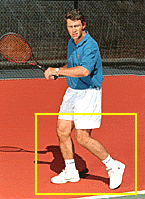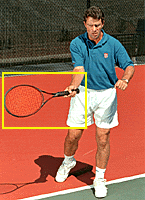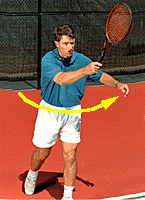|
TennisOne Lessons


Tom Stow and the"All Court Forcing Game"
Part 3: A Perfectly Square Collision
by Jim McLennan, Senior Editor, TennisONE
Go to: Part 1 | Part 2 |
With Tom Stow, everything was about the quality of the hit--bringing your weight against the ball, hitting the ball squarely, and getting the absolute maximum power from a relatively easy and slow swing. My constant project as a Stow pupil was to "swing slower and hit harder." Tennis is a game of control and accuracy, not a game of maximum power. And to swing easily yet hit hard, is the feeling of maximizing the power from a simple swing, and this simplicity lends control. This largely accounts for the classical style of players like Rosewall or Ashe (and now Sampras): their hits were big but their swings were never wild.
The trick for the writer is to capture the feel of the squarely hit ball, and convey it with words and graphics. As difficult as it was for me to learn to hit the ball to Tom's exacting specifications, this descriptive effort is equally difficult, but here goes.
To feel the absolutely squarest hit, it is important to create a head-on collision, where the momentum of the ball adds the greatest possible force to the resulting hit. In a word, this is the feeling of a "conk," which is short for concussion, and which always occurs when the ball is struck as described above. A heavily spun topspin (brushed upwards) shot will muffle the conk and often lead to pronounced mis-hits. What I am talking about is a very subtle topspin, perhaps 10 percent topspin, but a very square collision.

Stow taught his professional students to take the ball early (on the rise or at the top of the bounce), especially on the approach shots, where you want to move in on short balls and hit a penetrating shot to rob your opponent of reaction time. However, for learning to hit groundstrokes from behind the baseline, it's not as important to take the ball early. In addition, for intermediate students of the game, you must you must first learn to get a feel for the conk before worrying about taking the ball early. So here's what I suggest you practice. Stand on the baseline and have a friend stand on the service line nearest you and toss some balls underhanded so you can hit them easily. Let the ball drop into your hitting zone at roughly waist height, and this will probably mean the balls will just start descending as you make contact (see Figure 1).
Now as you evaluate the diagram, notice two things: 1) the racquet must be placed very slightly "open" to maximize this collision. Closing the face would increase the spin resulting from the collision. Closing the face too much would smother the ball, and just as would opening the face too much cause excessive backspin. 2) the plane of the racquet swing must be slight rising as the plane of the ball is slightly falling. The result will be a head-on collision and a conk.
In the photos below, I am demonstrating this open-faced topspin shot. In the first photo, note the fundamentals: 1) pivot and shoulder turn; 2) transfer of weight to the back foot; 3) most importantly for this stroke--the racquet is taken mostly straight back (although slightly elevated as I have done is just fine). Although the next photo doesn't show it, before my racquet moves forward, I've dropped the racquet head so that it is slightly below the level of the ball approaching. Then I've moved the racquet forward in a slightly ascending plane to create a square collision with the slightly descending flight of the ball. In the second photo, I am at the point of contact. My weight has been transferred to the front foot, and you can see open-faced racquet, which I've slightly exaggerated. Again, one might think the ball would sail high over the back of the baseline with this open-faced shot. But if the plane of your swing is slightly ascending and you swing levelly through the ball, you will start conking the ball. You'll hit with about 10 percent topspin, enough topspin to give you control, but most importantly, you'll hit it with enough penetrating force to qualify as a Tom Stow student of the All Court Forcing Game.
  
Today's premier topspinners (Chang, Muster, Sanchez, Vicario, Sabatini) usually hit their strokes with a very low-to-high swing to generate exaggerated topspin. While this technique certainly works, it can rob the player's shots of penetrating forcing power (produced by the relatively flat shots of an Agassi, Graf or Connors). When these exaggerated topspin shots are slightly mis-hit, they create a sound that Buddy Crovetto, a renown Louisiana golf and tennis pro, called "cssicks," a sharp contrast from the "conk."
So even if you already swing low-to-high and hit with a closed-faced racquet, give this open-faced topspin shot a try. On your first attempts, the ball will go incredibly high, not because the racquet face was open, but because the swing was still too low-to-high. Again, this is all about head-on collisions. Level out the back-swing and follow-through, work to swing through the hit rather than sharply up. You should immediately feel a more solid contact, and when the solidness becomes familiar (and note I believe that the vast majority of players never really learn to feel this simple hit) then you will understand how to swing slower and truly hit harder.
|
|




